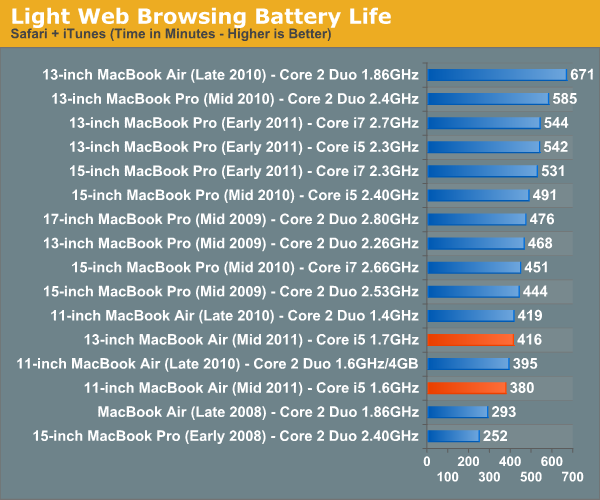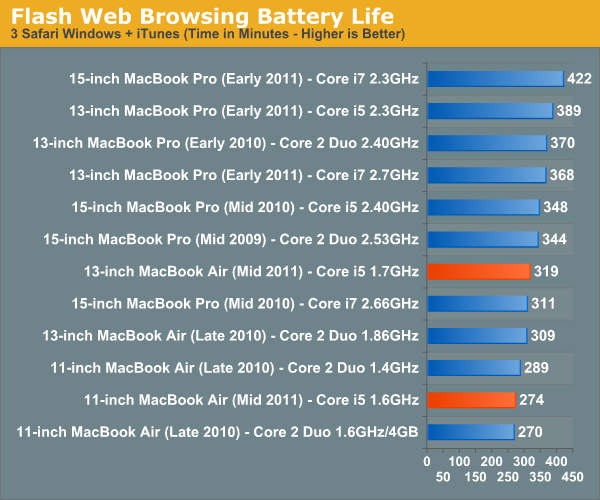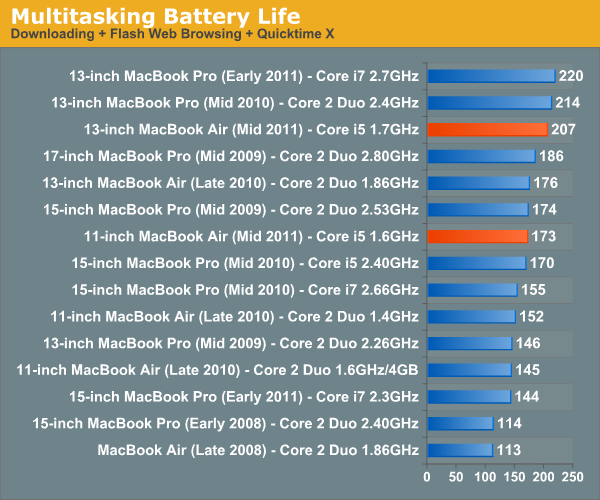The 2011 MacBook Air (11 & 13-inch): Thoroughly Reviewed
by Anand Lal Shimpi on July 28, 2011 3:25 AM EST- Posted in
- Apple
- Mac
- Intel
- Sandy Bridge
- MacBook Air
- Laptops
Battery Life
We've already established that the new MacBook Air lineup is significantly faster than its predecessor, but what does that do to battery life? Interestingly enough with a couple exceptions, not too much.
Let's look at the facts. Last year's MacBook Air used a 45nm Intel Core 2 Duo CPU paired with an NVIDIA chipset. The Core 2 is a very mature architecture that uses very little power under load. The 2011 Air gets the benefits of integration. The CPU and GPU are both on 32nm compared to 45/40nm for the previous generation. On top of that there's also power gating and architectural efficiencies to take into account.
The new Air models retain the same battery capacities as their predecessors: 35Wh for the 11 and 50Wh for the 13. It wasn't too long ago that the 15-inch MacBook Pro only had a 50Wh battery so this new 13-inch MacBook Air should be a good upgrade for users of older MacBook Pros even from a battery life standpoint.
Light Web Browsing
Here we're simply listening to MP3s in iTunes on repeat while browsing through a series of webpages with no flash on them. Each page forwards on to the next in the series after 20 seconds.
All screen savers are disabled, but the hard drive is allowed to go to sleep if there's no disk activity. The wireless connection is enabled and connected to a local access point less than 20 feet away. This test represents the longest battery life you can achieve on the platform while doing minimal work. The results here are comparable to what you'd see typing a document in TextEdit or reading documents.
Last year's 13-inch Air did amazingly well in our light web browsing battery life test, shattering even Apple's own expectations for the system. The new 13-inch MacBook Air doesn't fare as well.

While the new Air still delivers a respectable 6.9 hours of battery life in our lightest test, it's no where near what last year's model provided. If you're used to using your Air as a glorified typewriter, expect less battery life with the new model.
I'm not entirely sure why the 2010 13-inch MacBook Air did so well in our test. It lasted more than 60% longer than the 11-inch Air despite only having a 42% increase in battery capacity. There was something unique about that model that has since been lost.
The new 11 also loses out in the battery life department, but the drop isn't nearly as significant. The new 11 dies about 10% faster than last year's model in this test.
I should add that these results do generally support Apple's battery life claims for the MacBook Air. Apple lists the 13 as having up to 7 hours of battery life and the 11 with up to 5 hours.
Flash Web Browsing
The test here has three Safari windows open, each browsing a set of web pages with between 1—4 animated flash ads per page, at the same time. Each page forwards onto the next after about 20 seconds.
As always, the displays are set as close to one another as possible, audio at two bars, screensaver disabled and the hard drive is allowed to go to sleep if idle. The wireless connection is enabled and connected to a local access point less than 20 feet away.

Our light web browsing test is really the absolute best case scenario for battery life under OS X. I often use the term glorified typewriter because that's typically when you see these numbers: just typing away in a TextEdit window. For a writer, that's a valid usage model but for the majority of the population you'll be doing a bit more. This is where our Flash Web Browsing test comes in to play.
Here the numbers drop and the gap between last year's MBAs and the new systems shrinks to basically nothing. You can get around 5.3 hours of browsing duty out of the new 13 and a little over 4.5 hours from the new 11. Those numbers are near identical to last year's model, telling us that the increased power consumption of Sandy Bridge is almost entirely offset by better integration and the move to 32nm.
Multitasking Battery Life
Our final battery life test is the worst case scenario. In this test we have three open Safari windows, each browsing a set of web pages with between 1—4 flash ads per page, at the same time. We're also playing an XviD video in a window all while downloading files from a server at 500KB/s.

This test is really going to be the number a lot of power users see on a regular basis. Not giving the CPU much time to go to sleep results in very quick battery drain. Higher CPU demands also ensure that Sandy Bridge has room to flex its muscle, giving the new machines a bit of an advantage over last year's models. In a race to sleep, the faster CPU typically wins. If there's never any chance to sleep, the slower CPU usually lasts longer.
The new 13 does very well here, it's in the top 3 barely behind the 13-inch MBPs from last year and earlier this year. The 11 also puts forth a respectable effort, tying the 15-inch MacBook Pro from 2009/2010 and besting this year's model. Note that the 11 is significantly slower than the new 15-inch MacBook Pro, so while it'll last longer you may not be able to get as much done in the same amount of time. But compared to the rest of the systems in Apple's mobile lineup, the new Airs do relatively well under heavy load.
Looking at absolute numbers however the data is less impressive. The 13 is borderline acceptable with its 3.75 hours of battery life, while the 11 is a bit more disappointing at under 3.
The 11 vs. 13
If you're deciding on the 11 vs. 13, here's how the battery life breaks down between the two. On average you're going to gain another 38 minutes of usage with the 13-inch MacBook Air vs. the 11-inch model.
| OS X Battery Life Comparison | ||||||
| Light Web | Flash Web | Heavy Multitasking | Average | |||
| 13-inch MacBook Air | 416 minutes | 319 minutes | 207 minutes | - | ||
| 11-inch MacBook Air | 380 minutes | 274 minutes | 173 minutes | - | ||
| Advantage in Minutes | 36 minutes | 45 minutes | 34 minutes | 38 minutes | ||
| Advantage in Percent | 9.5% | 16.4% | 19.7% | 15.2% | ||
It looks like you'll see anywhere from an additional 10% to nearly 20% battery life from the 13. If we're talking time, the 13 will give you at least another half an hour of battery life from a full charge under OS X.










103 Comments
View All Comments
OCedHrt - Tuesday, August 2, 2011 - link
35W is maximum draw I think. On average you don't use that much, and on idle you save even less. My Z, as an entire system, draws 22W on average during browsing.darwinosx - Saturday, July 30, 2011 - link
If you had actually read the review or knew anything about the Sony Z you would know that this is a different ultra low voltage i5 processor that was just released. You would also know that Sony's are higher priced, poorly made, little service and support, and run Windows.OCedHrt - Tuesday, August 2, 2011 - link
I would know that my Z runs fast, plays my games, carries around just as light as an Air, is built to last, never needed support, and cost me less. And people still have their 3 gen old Z's running core duos going strong.The Z does not want a ULV processor. ULV is only good if you want to increase your battery life at the cost of performance. The Sony Z does not lose to Air in battery life at all. Just because something just came out doesn't necessarily make it ideal. Would there be a market for the new Z with ULV? Maybe, and it will then kill the Air in battery life and probably cost even less.
KPOM - Thursday, July 28, 2011 - link
As usual, a nice and thorough review. Thanks for the comparison to the i7, as well.Apple did a nice job with this one. They have created a mainstream "ultra book" months before the others come out with their blessed-by-Intel versions. It isn't as powerful as the Vaio X, but is more reasonably priced. It beats the relatively new Samsung Series 9 (which still relies on an i3 and less powerful graphics) while maintaining similar pricing. The i7 available in the 128GB 11" is a good deal at $1349. I opted for the 256GB 11" and got the Samsung (though the Toshiba would have been fine - I had one in my 2010 MacBook Air).
OCedHrt - Tuesday, August 2, 2011 - link
I hope you mean the Vaio Z. The X was amazing but it was a paper weight.iwod - Thursday, July 28, 2011 - link
The next gen of tech, Haswell, PCI-E 4.0, Thunderbolt 2.0, Faster SSD will be perfect fit for Macbook Air.lokiju - Thursday, July 28, 2011 - link
I wonder if Sony's Air challengers external GPU would work with this if you could get the physical ports adapted to fit...A external GPU would probably be more than it's worth for me but still a cool concept.
mschira - Thursday, July 28, 2011 - link
That last sentence made me think. Why not integrate the external graphic card into the external display?That would be neat.
M.
wicko - Thursday, July 28, 2011 - link
I think I would still prefer an external GPU kit or something. This way you still have choice in GPU and in monitor, including existing ones.tipoo - Thursday, July 28, 2011 - link
I'd prefer a separate box for the GPU so you don't have to toss the display when its outdated. With thunderbolt you could potentially connect the Air to the display, then daisychain the display to the GPU.